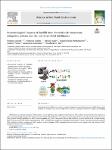Ecotoxicological impacts of landfill sites: Towards risk assessment, mitigation policies and the role of artificial intelligence.
Date
2024-06-01Author
Subject
Metadata
Show full item recordAbstract
Waste disposal in landfills remains a global concern. Despite technological developments, landfill leachate poses a hazard to ecosystems and human health since it acts as a secondary reservoir for legacy and emerging pollutants. This study provides a systematic and scientometric review of the nature and toxicity of pollutants generated by landfills and means of assessing their potential risks. Regarding human health, unregulated waste disposal and pathogens in leachate are the leading causes of diseases reported in local populations. Both in vitro and in vivo approaches have been employed in the ecotoxicological risk assessment of landfill leachate, with model organisms ranging from bacteria to birds. These studies demonstrate a wide range of toxic effects that reflect the complex composition of leachate and geographical variations in climate, resource availability and management practices. Based on bioassay (and other) evidence, categories of persistent chemicals of most concern include brominated flame retardants, per- and polyfluorinated chemicals, pharmaceuticals and alkyl phenol ethoxylates. However, the emerging and more general literature on microplastic toxicity suggests that these particles might also be problematic in leachate. Various mitigation strategies have been identified, with most focussing on improving landfill design or leachate treatment, developing alternative disposal methods and reducing waste volume through recycling or using more sustainable materials. The success of these efforts will rely on policies and practices and their enforcement, which is seen as a particular challenge in developing nations and at the international (and transboundary) level. Artificial intelligence and machine learning afford a wide range of options for evaluating and reducing the risks associated with leachates and gaseous emissions from landfills, and various approaches tested or having potential are discussed. However, addressing the limitations in data collection, model accuracy, real-time monitoring and our understanding of environmental impacts will be critical for realising this potential.
Collections
Publisher
Place of Publication
Journal
Volume
Pagination
Author URL
Publisher URL
Number
Recommended, similar items
The following license files are associated with this item:


